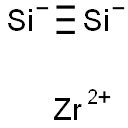DESIGN AND SYNTHESIZE OF NEW TERNARY ZIRCONIUM SILICIDE INTERMETALLIC COMPOUNDS WITH THE 16H CRYSTAL STRUCTURE
The zirconium silicide intermetallic compounds with the 16H crystal structure are good materials for high temperature structural applications, because of their high melting point and low density. Their shortcoming is low ductility. To increase ductility, the coordination numbers are increased to increase isotropy of bondings, and to have more metallic nature of bonds. Combination of elements, silicon, zirconium and other atoms for ternary silicides are selected by theoretical consideration of the coordination numbers. As the coordination numbers increase, the atomic bonds increase metallic properties, and their ductility increases. Higher coordination numbers are obtained by substituting yttrium atoms onto zirconium 6g point set sites.
To improve properties of intermetallic compounds, addition of elements and composites
are considered. In this work, new ternary intermetallic compounds are designed by
substituting of a part of atoms without crystal structure change. Celis et al. described that
it is possible to substitute a layer of zirconium atoms with titanium in Si3Zr5 without crystal
structure changes. Using these results, a method to design new ternary zirconium
silicide is described.
To increase ductility, coordination numbers are increased to enhance isotropical nature of bondings, and to have more metallic nature of bonds. In this work, design and synthesis of new ternary zirconium silicide intermetallic compound by substituting a part of zirconium atoms with other elements to increase the metallic nature of bondings in the 16H Si3Zr5 structure are discussed.
Figure 1 shows the Bravais lattice of
the (M5Si3)16H type crystal structure, where
M means a metallic element. Silicon and
M atoms at 6g point set are located on
basal planes B and C, and M atoms at 4d
point set are on basal plane A. Lattice
parameters determine the nearest neighbor
atomic distances. Lattice parameter a
controls the Si(6g)-M(6g) bonding distance
in basal planes B and C, for example
between Si( 0.00, 0.61, 0.25) and M( 0.25,
0.00, 0.25). Lattice parameter C fixes the
M(4d)-M(4d) bonding length, for example
M( 0.33, 0.67, 0.00)-M( 0.33, 0.67, 0.50),
i.e., between two basal planes A.
![Figure 1 Schematic representation of the Si 3M5 binary intermetallic compounds with the 16H crystal structure [2,5]. Article illustration](/NewsImg/2024-05-20/6385181692019777484839906.png)
CONCLUSIONS
(1) New ternary zirconium silicide intermetallic compound Si3Y3Zr2 is designed and synthesized by substituting a layer of zirconium atoms with a layer of yttrium atoms to increase the metallic nature of bondings to obtain reasonable ductility of Si3Zr5 with the 16H crystal structure.
(2) Density of this compound is lower than Si3Zr5 , making it an excellent candidate material for high temperature structural applications.
(3) The melting point of Si3Y3Zr2 may be similar to Si 3 Zr 5 due to higher coordination number.
References:
[1] Y. IKARASHI; K. I. Design and Synthesize of New Ternary Zirconium Silicide Intermetallic Compounds with the 16H Crystal Structure[J]. MRS Proceedings, 1993. DOI:10.1557/PROC-322-235.


